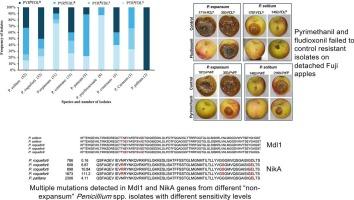High resistance levels to pyrimethanil and fludioxonil among fourteen Penicillium spp. from pome fruits in the U.S. Pacific Northwest
IF 4.2
1区 农林科学
Q2 BIOCHEMISTRY & MOLECULAR BIOLOGY
引用次数: 0
Abstract
In this study, 162 Penicillium isolates, i.e., 31 P. expansum isolates and 131 isolates from 13 other Penicillium spp. referred to as “non-expansum” were collected from apples and pears from multiple packinghouses in Washington State and Oregon. The sensitivity of the isolates to the postharvest fungicides pyrimethanil (PYR) and fludioxonil (FDL) was assessed in vitro. The mean EC50 value for PYR was 0.75 μg/mL in P. expansum compared to 1.63, 3.47, 6.95, 7.06 and 32.21 μg/mL in P. solitum, P. palitans, P. commune, P. roqueforti and P. carneum, respectively. For FDL, the mean EC50 value was 0.04 μg/mL in P. expansum compared to >0.80, 1.00, 10.40, 13.99, and 158.10 μg/mL in P. commune, P. palitans, P. roqueforti, P. solitum, and P. paneum, respectively. Overall, > 40 % of isolates from five “non-expansum” species showed dual resistance to PYR and FDL versus 9.6 % in P. expansum. The recommended rates of PYR and FDL failed to control isolates of six Penicillium spp. on detached apples after five months at 1.5 °C. Sequencing of the Mdl1, NikA, and Os1 genes from different isolates of eight species revealed a high polymorphism in the Mdl1 and NikA of several “non-expansum” species. Three and two concurrent mutations, in addition to a G409R and S959, were detected in the Mdl1 and NikA, respectively, that potentially confer resistance to PYR and FDL. The high level of resistance and the control failure observed on fruits highlight the potential risk posed by several “non-expansum” Penicillium species to pome fruit packers.

美国西北太平洋地区 14 个青霉属对嘧菌酯和氟虫腈的高抗药性
在这项研究中,从华盛顿州和俄勒冈州多个包装厂的苹果和梨中收集了 162 株青霉分离物,即 31 株扩张青霉分离物和 131 株其他青霉属分离物(称为 "非扩张青霉")。对这些分离物对采后杀菌剂嘧菌酯(PYR)和氟虫腈(FDL)的敏感性进行了体外评估。Expansum 对PYR 的平均 EC50 值为 0.75 μg/mL,而对 Solitum、P. palitans、P. commune、P. roqueforti 和 P. carneum 的 EC50 值分别为 1.63、3.47、6.95、7.06 和 32.21 μg/mL。对于 FDL,扩张叶绿体的平均 EC50 值为 0.04 μg/mL,而共生叶绿体、palitans 叶绿体、roqueforti 叶绿体、solitum 叶绿体和 paneum 叶绿体的平均 EC50 值分别为 0.80、1.00、10.40、13.99 和 158.10 μg/mL。总体而言,来自五个 "非扩张型 "物种的分离物中有 40% 对PYR 和 FDL 具有双重抗性,而在扩张型牛肝菌中只有 9.6%。在 1.5 °C 温度条件下生长 5 个月后,PYR 和 FDL 的推荐用量未能控制脱落苹果上的 6 个青霉属的分离物。对 8 个物种不同分离株的 Mdl1、NikA 和 Os1 基因进行测序后发现,几个 "非扩张青霉 "物种的 Mdl1 和 NikA 基因存在高度多态性。除了 G409R 和 S959 外,在 Mdl1 和 NikA 中还分别检测到三个和两个并发突变,这两个突变有可能赋予PYR 和 FDL 抗性。在水果上观察到的高水平抗性和控制失败突出表明了几种 "非扩张 "青霉对梨果包装商造成的潜在风险。
本文章由计算机程序翻译,如有差异,请以英文原文为准。
求助全文
约1分钟内获得全文
求助全文
来源期刊
CiteScore
7.00
自引率
8.50%
发文量
238
审稿时长
4.2 months
期刊介绍:
Pesticide Biochemistry and Physiology publishes original scientific articles pertaining to the mode of action of plant protection agents such as insecticides, fungicides, herbicides, and similar compounds, including nonlethal pest control agents, biosynthesis of pheromones, hormones, and plant resistance agents. Manuscripts may include a biochemical, physiological, or molecular study for an understanding of comparative toxicology or selective toxicity of both target and nontarget organisms. Particular interest will be given to studies on the molecular biology of pest control, toxicology, and pesticide resistance.
Research Areas Emphasized Include the Biochemistry and Physiology of:
• Comparative toxicity
• Mode of action
• Pathophysiology
• Plant growth regulators
• Resistance
• Other effects of pesticides on both parasites and hosts.

 求助内容:
求助内容: 应助结果提醒方式:
应助结果提醒方式:


